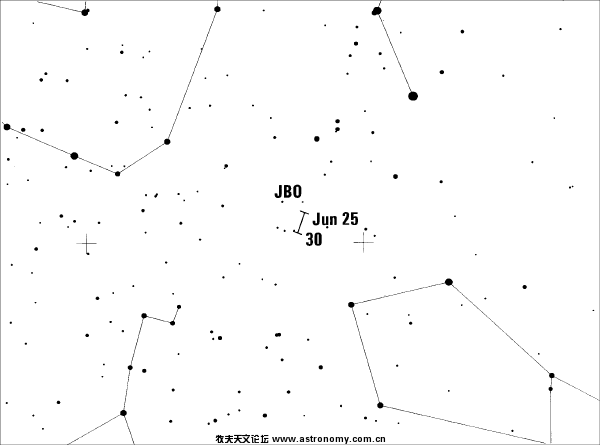本帖最后由 meteorobs 于 2011-6-25 23:32 编辑
贪星鬼 2011年06月24日 13:29
http://user.qzone.qq.com/294095459/blog/1308893353
一个辐射点位于牧夫座、武仙座和天龙座之间的流星雨,在每年六月下旬至七月初活动,我们称之为六月牧夫流星雨,英文简称JBO。
通常年份六月牧夫流星雨的流量并不大,ZHR 在20以下。1998年曾经出现过ZHR 100以上的爆发,并且极大持续了大约半天之久。2004 年极大时的ZHR也达到了50左右。六月牧夫流星雨的母彗星是7P庞斯.温尼克彗星,公转周期6.38 年,上次回归近日点是在2008年9月。根据观测发现,1998年和2004年的两次爆发都与母彗星19世纪某次回归时留下的尘埃团有关。今年恰逢母体回归,最近时距离地球仅0.24个天文单位。预计有小爆发的可能,预计极大将出现在北京时间6月28日5时,乐观估计ZHR可能在100左右。对于我国的观测者来说,27日至28日这一晚的观测条件都不错。以北纬40°左右地区为例,天黑后不久辐射点非常接近天顶,而且整夜的观测都不会受月光影响。惟一的遗憾是六月牧夫流星雨的极大非常接近夏至,我们可以进行常规目视和照相观测的时间只有5个小时左右。大家可能还没看过瘾,天就已经亮了。
然而,就连天文学家对六月牧未流星雨都不大熟悉,关于它的极大时间和流量的预报也都有一定不确定性,我们只能根据国际流星组织的预报进行分析后呈现给大家。因此希望有兴趣的朋友可以尽量多地进行观测,积累更多的观测资料,有助于我们更好地认识六月牧夫流星雨。
June Boötids (JBO)
Active: June 22 – July 2; Maximum: June 27, 21h UT (λ⊙ = 95.7°), but see text;
ZHR = variable, 0–100+;
Radiant: α = 224°, δ = +48°; Radiant drift: see Table 6;
V∞ = 18 km/s; r = 2.2;
TFC: α = 156°, δ = +64° and α = 289°, δ = +67° (β = 25°–60° N). |
牧夫座流星雨辐射点位置示意图:

This source was reinstated on the Working List after its unexpected return of 1998, when ZHRs of 50–100+ were visible for more than half a day. Another outburst of similar length, but with ZHRs of ∼ 20–50 was observed on 2004 June 23, a date before definite activity had previously been recorded from this shower.
Consequently, the shower's start date was altered to try to ensure future activity so early is caught, and we encourage all observers to routinely monitor throughout the proposed activity period, in case of fresh outbursts. The predicted possible activity in 2010 was still to come when this text was prepared. Prior to 1998, only three more probable returns had been detected, in 1916, 1921 and 1927, and with no significant reports between 1928 and 1997, it seemed likely these meteoroids no longer encountered Earth. The dynamics of the stream were poorly understood, although recent theoretical modelling has improved our comprehension. The shower's parent, Comet 7P/Pons-Winnecke, has an orbit that now lies around 0.24 astronomical units outside the Earth's at its closest approach. Its most recent perihelion passage was in 2008 September. Clearly, the 1998 and 2004 returns resulted from material shed by the comet in the past which now lies on slightly different orbits to the comet itself. Dust trails laid down at various perihelion returns during the 19th century seem to have been responsible for the last two main outbursts. No predictions for activity are in-force for 2011, but conditions for checking are very favourable from the mid-northern latitudes where the radiant is best-seen (indeed it is usefully-observable almost all night from here), with only a waning crescent Moon on June 27. The prolonged – in some places continuous – twilight will cause difficulties, however. VID has suggested some June Boötids may be visible in most years around June 20–25, but with activity largely negligible except near λ⊙ = 92° (2011 June 24), radiating from an area about ten degrees south of the visual one found in 1998 and 2004, close to α α = 216°, δ = +38°。 |
|